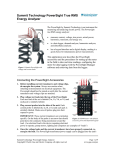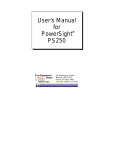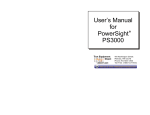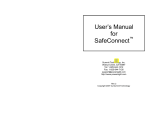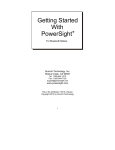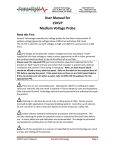Download Summit Technology Inc
Transcript
Using PowerSight as a Front-End for Automatic Data Collection PowerSight can automatically supply relevant measurements to your Data Collection system. Introduction Every PowerSight meter has an “Automatic Data Reporting” mode of operation built into it. Following power-up, a single command from a host system can put PowerSight in this mode. While in the mode, PowerSight reports the relevant RMS voltages, PMS currents, true power, and apparent power information to the host once per second. Once started, this mode continues until either PowerSight is turned off or a command to exit the mode is received. The summary data is provided in a rigidly-defined binary floating point format. It is provided without being prompted, once per second. Communications Basics for Automatic Data Reporting Mode The data communications speed depends on the speed that your PowerSight can support. PS250 and PS3000 meters are limited to 9600 baud. PS4000 can be set at all common data speeds from 9600 to 115.2kbps. However, communications above 57.6kbps can be less reliable, depending on operating conditions. Characters for an RS232 link are sent with 1 start bit, followed by 8 data bits, and ending with 1 stop bit. Communications are half-duplex. PS250 and PS3000 meters will not receive commands while doing harmonic analysis, so it is best to have them out of that recording mode when initiating Automatic Data Reporting mode. PS250 and PS3000 may delay in their response to communications up to one second, so there needs to be at least a one second timeout when waiting for a response from those meters. Characters are transmitted to and received from PowerSight starting with the most significant bit (bit 7) and ending with the least significant bit (bit 0). Initiating Automatic Data Reporting mode PowerSight must be powered “on” and connected to the host system via its serial link. To verify that the serial link is working, you may wish to use our PSM software to “Connect to Unit”. A successful connection (the green “Unit Connected” bar appearing), indicates that all the physical and data link layers are working correctly. The command to PowerSight to initiate Automatic Data Reporting mode is: 1. transmit 0xFF to PowerSight to indicate the beginning of a command 2. transmit the meter’s single byte network identifier or transmit 0x00 to indicate that this is a broadcast message. In most cases, the host is communicating to just one meter via the link so 0x00 is a good choice since it will work with any meter that may be connected. If you do send out the network identifier, you must wait for an acknowledge character (0x01) from the meter before you proceed to the next step. 3. Transmit the command byte. To initiate Automatic Data Reporting mode, send the ASCII “V” character (0x56). Page 1 of 3 Using PowerSight as a Front-End for Automatic Data Collection 4. 5. Wait for an acknowledge character (0x01) from the meter. If the acknowledge is not received in 5 seconds, repeat steps 1 through 3 until you get the acknowledge Following receipt of the acknowledge character, the meter will automatically send the summary information to the host at the conclusion of each second. Receiving Data in Automatic Data Reporting Mode The order of receiving data while in Automatic Data Reporting mode is: 1. Synchronizer characters (2 bytes, 0xFF followed by 0xEF) 2. RMS voltage of each phase (3 x 4 = 12 bytes) 3. RMS current of each phase and neutral (4 x 4 = 16 bytes) 4. True power of each phase (3 x 4 = 12 bytes) 5. Apparent power of each phase (3 x 4 = 12 bytes) 6. Operating modes (1 byte) 7. checksum (1 byte) Interpreting Data in Automatic Data Reporting Mode Although the data received is always the most relevant data, given the operating mode of PowerSight, its meaning varies, depending on the operating modes of PowerSight. The voltages are Van, Vbn, and Vcn when operating in phase-neutral mode. They are Vab, Vbc, and Vca when operating in phase-phase mode. They are Vab, Vbc, and Vcb when operating in 2 current mode. In all cases, the volts are reported in binary 4 byte floating point format and scaled in decivolts (i.e. 12.3 V is reported as 123, in floating point format). The currents are Ia, Ib, Ic, and In. When in 2 current mode, Ib may or may not be present, but it has no bearing on the power readings. In all cases, the current is reported in milliamps (i.e. 12.3 A is reported as 12,300, in floating point format). The true powers are Wa, Wb, and Wc. When in “positive power only” mode, they are reported in deciwatts (i.e. 12.3 W is reported as 123, in floating point format). When in “negative power allowed” mode, they are reported in watts (i.e 12.3 W is reported as 12). When in 2 current mode, depending on the firmware of the meter, the Wa term may express the Vac*Ia term of total power, the Wb term will equal 0, and the Wc term will express the Vcb*Ic term of total power. In this case, The Wa, Wb, and Wc terms do not actually represent the true power of each phase, although their total is the correct total true power. The apparent powers are VAa, VAb, and VAc. They are reported in deciVA (i.e. 12.3 VA is reported as 123, in floating point format). The Operating Modes byte is a bit-mapped value. Interpreting it correctly is key to interpreting the data that is received. However, in most cases you will already know the operating modes that are active in PowerSight, so you will not need to interpret this byte since you will already know how to interpret all the data (as explained earlier in this section). Only the lower 3 bits of the Operating Mode byte are used. The following chart tells how to interpret the bits: Page 2 of 3 Using PowerSight as a Front-End for Automatic Data Collection Bit 2 0 0 0 0 1 1 Bit 1 0 0 1 1 0 1 Bit 0 0 1 0 1 x x Interpretation of Operating Mode Byte Phase-neutral voltage, Positive power only Phase-phase voltage, Positive power only Phase-neutral voltage, Negative power allowed Phase-phase voltage, Negative power allowed 2 current mode, Positive power only 2 current mode, Negative power allowed The checksum is the sum of all characters transmitted during the once-per-second update (including the synchronizer bytes but not including the checksum itself). It is presented modulus 256 (i.e. the lowest byte of the sum, commonly referred to as an “8-bit checksum”). Using Data Obtained From Automatic Data Reporting Mode Once the voltages, currents, true powers, and apparent powers are received. They can yield additional measurements of great interest. Specifically: Wt = total true power = Wa + Wb + Wc. VAt = total apparent power = VAa + VAb + VAc TPFa = true power factor of A phase = Wa/VAa. TPFb = true power factor of B phase = Wb/VAb. TPFc = true power factor of C phase = Wc/VAc. TPFt = total true power factor = TPFa + TPFb + TPFc. Please note: VAb, VAt, TPFb, and TPFt cannot be calculated in 2 current mode. Terminating Automatic Data Reporting mode Automatic Data Reporting mode can be terminated by either turning PowerSight off and then back on or by sending the terminating command to it. To send the terminating command, PowerSight must be “on” and connected to the host system via its serial link. The communications sequence to terminate the mode is identical to the sequence used to start the mode except the command byte that is sent to the meter is “v” (0x76). If the command transmission is successful, the meter will acknowledge receipt of the command (0x01) and then be silent. For more information on our products contact: Summit Technology Inc. 2717 N. Main St., Suite 15 Walnut Creek, CA 94597 Voice: 1-925-944-1212 Fax: 1-925-944-7126 Email: [email protected] ® PowerSight is a trademark of Summit Technology. Prices and specifications are subject to change without notice. Page 3 of 3



